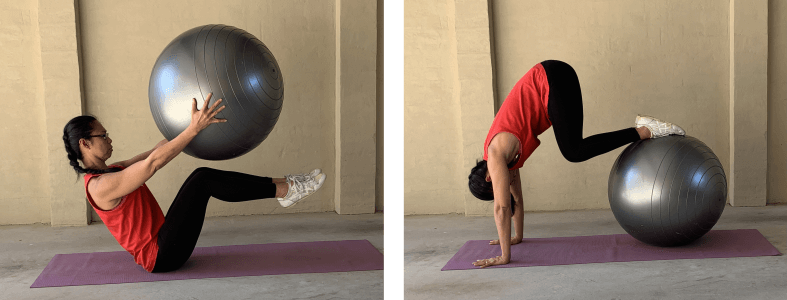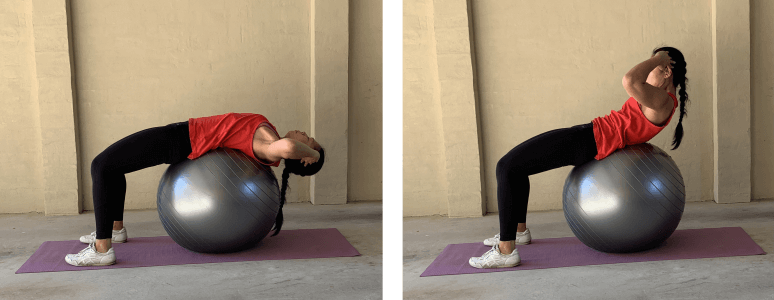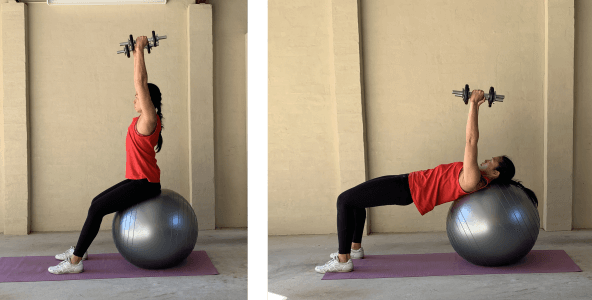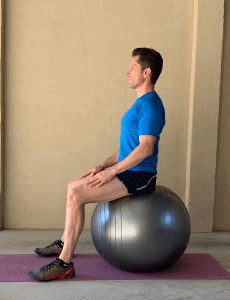Exercise Ball
The exercise ball is also referred to as a stability ball, fit ball, Swiss ball, gym ball or Physioball. It’s a versatile piece of equipment used for many forms of exercise such as:
- Core strengthening
- Aerobics
- Stretching
- Pilates
- Yoga
- Rehab exercises
I use the ball primarily for ab and core strengthening exercises and for increasing the difficulty of specific exercises due to its unstable surface.

Performing specific resistance exercises on the exercise ball creates an unstable base; therefore, your body must recruit the stabiliser muscles (core muscles) to remain balanced.
For example, try performing a seated dumbbell shoulder press on an exercise ball. You will find that your body, especially the core muscles, have to work harder to stabilise itself.
Benefits of the exercise ball
Improve core strength, stability, and posture
Core muscles are the abdominal and back regions of the body. These muscles are crucial for proper body posture and help stabilise the body during everyday activities like walking.
Just sitting on one of these balls will work your core muscles. If you don’t believe me, try sitting on one instead of a chair for half an hour in an upright position. The next day you will notice that your stomach muscles will be a little sore. This soreness indicates that your core muscles were engaged and worked while sitting on the ball.

Better control
Using the ball for core or strength training exercises forces you to work a bit slower with better control to prevent you from losing your balance or falling off the ball. Having better control also allows you to perform an exercise correctly.
Better balance
Ball training helps to develop strength and balance simultaneously.
Better balance helps improve your stability and prevent falls, especially in older adults. Better balance can also help athletes execute a challenging manoeuver in their particular sport.
Work the body as a unit
When performing an exercise on the ball, you are forced to maintain your balance and centre of gravity because the unstable, mobile base allows you to work the entire body as a unit.

For example, your legs will also be engaged when performing a seated exercise like a dumbbell shoulder press or a lying down exercise like a dumbbell chest press. In addition, when performing an inverted exercise like a plank knee tuck, your shoulders and arms will also be engaged.
Choosing the right ball

Ensure you get a good quality anti-burst exercise ball with a soft non-slip surface. These balls have a heavier user weight, and if it gets punctured, they will deflate slowly.
Make sure that your ball is well inflated, so there is not a lot of compression when you press on the ball.
The ball generally comes in different sizes. The main sizes that we use are - small (55cm), medium (65cm), or large (75cm).
When doing sitting exercises, the general rule that we go by is you need to sit on top of the ball with your feet flat on the ground to have good balance and support yourself safely. Secondly, have the hips slightly higher than the knees so you can maintain the natural curve in your lower back. Finally, this sitting position forces you to engage your core muscles to maintain an upright posture.
References:
‘Ultimate Core Ball Workout’ by Jeanine Detz, 2005.
‘Strength Training On The Ball’ by Colleen Craig, 2005.